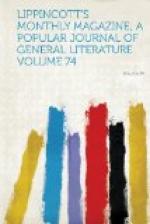No attempt was made to prove that Mrs. Wharton had at any time in her possession strychnia, the poison alleged to have been used by her. As on the previous trial, the case centred upon the expert testimony, but there was no direct chemical evidence, neither the food, the matters vomited nor the bodily secretions having been examined. Some sediment found in a tumbler of punch was asserted by Dr. Aiken to consist largely of tartar emetic. This tumbler was not connected with Mrs. Wharton, except by being found at her house in a position where, in the language of one of the State’s witnesses, “hundreds of persons” had access to it. It was carried about in the pocket of a lady inimical to Mrs. Wharton, and into at least one drug-store, before it reached Professor Aiken, whose analysis was as faulty as before. Any tartar emetic present in the sediment might have been procured in a pure form by the simple process of dialysis. The only apparatus necessary for this would have been a glass vessel divided into two compartments by a piece of hog’s bladder stretched across it. These chambers having been partially filled with distilled water, and the sediment of the tumbler put into one of them, the tartar emetic would have left the other ingredients and passed into the second compartment. By taking the water out of this and evaporating it, the poison would have been obtained in a pure crystalline state, and might have been brought into court. But Dr. Aiken thought it sufficient for him to “satisfy himself:” as he stated on the witness-stand, he did not consider it his business whether other people were or were not satisfied. Consequently, the court was only favored with a memorized report of the color tests used by him, exactly as in the previous trial. One of the reactions which he said he obtained antimony does not conform to.
Drs. Williams and Chew unhesitatingly stated on the witness-stand that they recognized poisoning as early as the Saturday of Mr. Van Ness’s illness.[23] Yet they gave no antidote. They employed on Monday and Tuesday a treatment which, although well adapted to a case of natural disease presenting such symptoms, would in a case of poisoning have materially increased the risk to life. They did not save the matters vomited: they did not save the secretions, which would certainly have contained antimony if Mr. Van Ness had been poisoned as alleged. According to their testimony, Mr. Van Ness received six doses of poison on as many different days, four of the doses administered under their eyes; yet they gave no warning to the unfortunate victim or to his friends. If the theory they upheld be correct, that Mrs. Wharton poisoned both General Ketchum and Mr. Van Ness, the extraordinary spectacle was presented of one man lying dead in the house from the effect of poison, of another receiving day after day the fatal dose with the knowledge of the attending physician, yet no antidote given, no warning word put forth, no saving of the evidences of guilt! It would seem as though silence at a trial would best become gentlemen with such a record, yet they were the only experts who asserted that strychnia was the sole possible cause for the attack of the 24th of June, and tartar emetic of the subsequent attacks.




